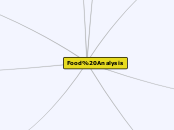jonka Nur Aini 7 vuotta sitten
548
Food Analysis

jonka Nur Aini 7 vuotta sitten
548

Lisää tämän kaltaisia
Advantages: Not measure non-protein N No corrosive reagent More precise Disadvantages: Not sensitive Non-protein components bind with dye Proteins differ in basic amino acids content
Advantages: Relatively simple Very sensitive More specific Disadvantages: Colour is not propotional to protein conc. Reaction interfere with sucrose, lipids interfered with high conc. of reducing sugar
Advantages: Rapid test Not detect N from non-peptide or non-protein Few substance interfere with the biuret reaction Disadvantages: Low sensitivity Not an absolute method Opalescence could occur
Advantages: Accurate & good reproducibility Simple Inexpensive Disadvantages: Corrosive reagent Not measure true protein Time consuming
Milk + ionic detergent (Dioctyl sodium phosphate) Add Hydrophilic polyoxyethylene detergent Fat is measured volumetrically
Advantages : Non corrosive properties
Milk + H2SO4 and Amyl alcohol, carefully inverted centrifuged and incubated in water bath (5 mins) Fat content read directly from the tube
Advantaged : Wider application for dairy products Simpler and faster
H2SO4 + milk, shaken until homogeneous, centrifuged, submerged into H2O Addition of hot H2O (isolate fat), measure volumetrically
Disadvantages : Charring effect of sugar
Extracted with mixture of ethyl & pet-ether Extracted fat is dried - constant weight Modified : use acid pre-treatment (HCL) - flour
Same method as Goldfisch Solvent - built up in extraction chamber (5-10 mins), soaking the sample, siphon back to the boiling flask. 4-6 hrs
Advantages : Increase the efficiency Disadvantages : Time consuming
Sample - in an extraction ceramic thimble Solvent - added in boiling flask > 4 hrs extraction, air-drying overnight brief oven-drying, remaining is weight (fat)
Advantages : Faster & more Efficient Disadvantages : Incomplete extraction / channeling of solvent
Niacin + Cynogen bromide -> coloured complex
Disadvantages: Toxic reagent
Thiamine digest with sulphuric acid and treated with phosphate Potassium fericyanide/H2O2 oxidised in alkaline solution, extracted with iso butyl alcohol -> Thiochrome (blue colour)
Ascorbic acid oxizide by O-phenylenediamine -> dehydroascorbic acid ( fluroscent quinoxaline)
L-ascorbic acid oxidize by indicator dye -> dehydroascorbic acid End point, unreduced dye -> rose pink for 10 sec
Involve in chromatographic separation and quantitative at 325nm
Vitamin A + antimony trichoride -> unstable blur colour, read at A620nm
Disadvantages: Cannot differentiate ratinol isomers and retinal esters
Advantages: Less chance of losing trace minerals Utilization of O2 as sole reagent Disadvantages: Small sample capacity Expensive equipment
Advantages: Minerals stay in solutions No loss from mineral volatilization Disadvantages: Hazardous Corrosive reagent
Advantages: Safe No added reagent Large number of crucible can be handle at once Disadvantages: Time consuming Loss of volatile elements at high temp Interaction between mineral and crucible
Total CHO: 100 - (% moisture + % protein + % fat + % ash)
Disadvantages: Inaccurate result for CHO Incomplete digestion or extraction of food constituents Does not differentiate between available and non- available CHO
Measure content of dissolves solids in sugars solutions
To measure chiral susbtance To measure the angle that plane polarized light is rotate on passing through a solution
Disadvantages: Unable to analyzed mixture of CHO
Modification of Munsun-Walker and Lane-Eunon Method
Heated with alkaline copper tartrate add reduce copper -> cupros oxide, treated with arsenomolybdate reagent -> intense, stable blue-colour solution Abs is determined
Advantages: Applicable for low containing CHO
Oxidation CHO + heat, excess copper sulfate and alkaline tartrate -> ppt of copper oxide Amount of ppt = conc. of reducing sugar Modification: excess alkaline copper citrate with sodium carbonate. Reduction, excess copper citrate + potassium iodide, titrates with sodium thiosulfate
Advantages: More reproduceable and accurate
Reducing sugar + copper sulfate react with alkaline tartrate, boiled + methylene blue (indicator) -> coloured solution, titrated -> decolouration of indicator
Disadvantages: Not stoichiometric Cannot distinguish different type of reducing sugar
From TDF 1) Duplicate of dry & defatted Enzymatical (alpha-amylose, amyloglucosidase & protase Total fiber -> add 95% ethanol -> filter (soluble & insoluble) Insoluble: collected by filtration Soluble: add 78% ethanol, filtre 2) Duplicate of ash content
Disadvantages: Only measure Cellulose & Lignin Not calculate all fiber Not get specific amount
Solvent less dense (toluen) or more dense (tetrachloroethylene) than H2O
Immiscible solvents with higher boiling point that H2O
Infrared (IR) Drying
Microwave Oven
Vacuum Oven
Convection & Forced Draft Oven
Type of sample
Type of oven used & conditiond
Time & temp of drying
Thermal energy used